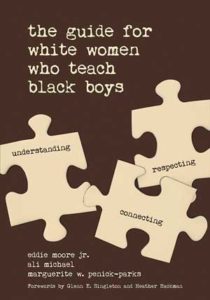The Guide for White Women Who Teach Black Boys
Reviewed by Patience A. Schenck
September 1, 2018
 Edited by Eddie Moore Jr., Ali Michael, and Marguerite W. Penick-Parks. Corwin, 2018. 472 pages. $27.95/paperback or eBook.
Edited by Eddie Moore Jr., Ali Michael, and Marguerite W. Penick-Parks. Corwin, 2018. 472 pages. $27.95/paperback or eBook.
Some years ago, an elderly couple in my family visited New Mexico. When I asked the man about the trip, he said, “Good trip; the people were especially interesting. They were about a third Indian, about a third Mexican, and about a third . . . um . . . you know . . . regular people.”
Regular people? It didn’t sound right, but at that time I didn’t understand that whites typically see themselves as the norm and their culture as the one that other groups should aspire to. White teachers’ awareness that their culture is only one option rather than the right one is given the highest importance in The Guide for White Women Who Teach Black Boys.
This book is a collection of essays. Among the editors is Dr. Eddie Moore, founder of the annual White Privilege Conference that many Friends have attended.
Why white women? Why only black boys? Because 82 percent of elementary and secondary teachers in U.S. public schools are white, and 76 percent are female, and the four-year graduation rate for black males is only 59 percent, compared to 80 percent for white males. A tragic number of black boys never connect with school, but rather, get caught up in the “school-to-prison pipeline.” Furthermore, many of the innovations a teacher would make to better serve black boys would be beneficial to all children.
So why is an awareness of whiteness so important for white teachers (and white Friends)? For one thing, whites see themselves as individuals above all. Therefore, they don’t find racial identification to be of significance. Because the school curricula and the media mostly reflect the same cultural references, preferences, and biases, they see them as normal and superior. Other groups, because they are oppressed based on their racial identity and because there are differences between their ways and dominant white ways, do see themselves as distinct groups. Unfortunately, white teachers typically perceive black life as a deficit; as a result, they approach teaching with a “savior” mentality. With more awareness that whiteness is just one of the options, teachers are better able to appreciate the richness of the cultures of children of color and to notice the brilliance and giftedness among children they teach.
Black boys get the message early that they are not intelligent, that they are scary, that they will likely go to prison, that they may not live to be 20. I once overheard an 11-year-old boy ask his friend if he was going to get married when he grew up. The boy said, “No, not me. When I grow up, here I go, off to jail!” Teachers must actively counter this narrative and offer them a counternarrative. Preserving the dignity of black boys is of the utmost importance.
People of color talk about race all the time at home and in other protected spaces. White teachers are often uncomfortable discussing race at all, but they need to talk openly about different racial groups and elicit the experiences of their students. This not only enriches the understanding of students and teachers alike, it also shows respect for all students.
I remember an English lesson I conducted with a class of mostly black fifth graders. My students were arguing with me about the word “ain’t,” and I decided to veer from my lesson plan and ask them to tell me some ways kids in their neighborhood talk that is different from their white classmates. They were totally engaged as we talked about “woofing,” which I learned means a stylized, aggressive boasting that I had frequently observed but never acknowledged. Were I teaching today, I would do a lot more drawing out of my students. We all grew that day in understanding of and respect for one another. Teachers must create “identity safe” classrooms in which they help students see their social identity as an asset, not a barrier to their academic success, a place where children of all backgrounds are valued.
Because textbooks are usually written from a white point of view, teachers must help kids notice what is missing. Is slavery presented honestly with more than a passing mention? Here is a place where the white teacher needs to have moved beyond embarrassment and shame in talking about race.
Are black scientists and writers included in the curriculum? Teachers will have to search out resources other than textbooks. Black students need to see black role models. In particular, gay, trans, and disabled black boys need to see successful role models like them.
The book emphasizes the importance of getting to know more about black boys, both individually and as a group. The teacher should keep in close touch with parents, phoning them to report successes as well as misbehavior. She should listen to parents as well as report to them, asking, “How can I better help your child develop his gifts?” She must understand that black parents love their kids as much as white parents. And she will have to earn the trust of parents.
To understand the neighborhood, some articles suggest visiting homes, churches, and other gathering places. Get comfortable in these settings. Get a feel for them.
I wish I had had this resource as a teacher.



Comments on Friendsjournal.org may be used in the Forum of the print magazine and may be edited for length and clarity.